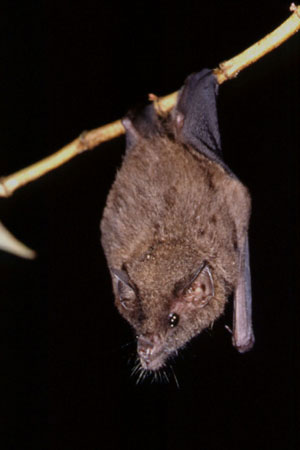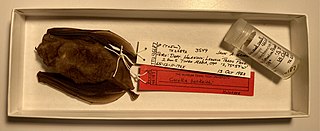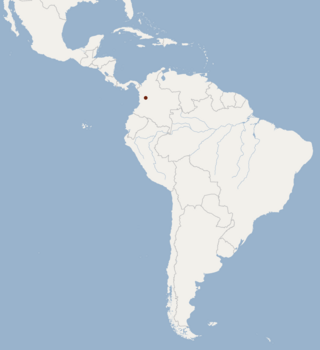
The tailed tailless bat is a species of leaf-nosed bat from South America.

Geoffroy's tailless bat is a species of phyllostomid bat from the American tropics.

Andersen's fruit-eating bat is a bat species found in South America.

The little big-eared bat is a bat species in the order Chiroptera and family Phyllostomidae. It is from South and Central America particularly Colombia, Venezuela, Guyana, French Guiana, Brazil, Peru, Ecuador, Bolivia, Argentina, Paraguay, Suriname and Trinidad. Though its exact population is unknown, it is considered widespread and occurs in protected areas, although deforestation may be a minor threat, it is classified as Least Concern. It is found in multistratal evergreen forests and dry thorn forests and forages near streams and is found hollow trees, logs, caverns, or houses with groups up to twelve. The head and body length measures at 44 millimetres (1.7 in) for males and 45 millimetres (1.8 in) for females. Males usually weigh about 5 grams (0.18 oz) while females weigh 5.7 grams (0.20 oz).

The great stripe-faced bat or stripe-faced vampire bat is a bat species found from southern Mexico to Bolivia and northwestern Brazil, as well as on Trinidad. The great stripe-faced bat is a frugivore. It is one of two species within the genus Vampyrodes the other being Vampyrodes major.

Anoura is a genus of leaf-nosed bats from Central and South America. Anoura members lack or have a short tail, and are nectarivorous bats of small to medium size among the Phyllostomidae.

Handley's tailless bat is a species of bat in the family Phyllostomidae. It is found in Bolivia, Colombia, Costa Rica, Ecuador, Panama, Peru, and Venezuela.

Handley's nectar bat is a species of bat in the family Phyllostomidae. It is found in Colombia, Ecuador, and Peru.

The Bogotá yellow-shouldered bat is a species of bat in the family Phyllostomidae. It is found in Colombia, Ecuador, Peru, and Venezuela at altitudes from 300 m to above 2000 m, particularly in cloud forest. The species is primarily frugivorous; it may also consume nectar and pollen.

The lesser yellow-shouldered bat is a species of bat in the family Phyllostomidae. It is native to Peru and Ecuador. It is threatened by habitat loss.
Rosenberg's fruit-eating bat is a species of bat in the family Phyllostomidae. It is found in humid tropical forests in the El Chocó region on the coast of western Colombia and northwestern Ecuador at altitudes below 500 m. Until recently it was included within D. glauca, a canopy frugivore that also eats insects. It was elevated to full species status in 2009. The specific name is in honor of collector W. F. H. Rosenberg. The species is regarded as common, but is likely threatened by the deforestation of its habitat.

Benkeith's short-tailed bat is a leaf-nosed bat species found in Peru, Bolivia, and Brazil. It very closely resembles the chestnut short-tailed bat, and the two species are likely often confused.

The Mistratoan yellow-shouldered bat, is a species of leaf-nosed bat indigenous to the Cordillera Occidental, in the Mistrato municipality in Risaralda, Colombia. Since existing information derives exclusively from the holotype, the status of the species, its environmental requirements, and the trend of the population are unknown.

Anoura peruana is a species of bat from Colombia and Peru. It was elevated to a species in 2010, after previously being considered a subspecies of Geoffroy's tailless bat. The females are larger than the males.

The Matapalo broad-nosed bat is a species of leaf-nosed bat described in 2005. It is found in South America.
The Chocoan long-tongued bat is a species of bat found in South America. It was described as a new species in 2004.

Cadena's tailless bat is a species of bat native to Colombia. In 2006 it was described as a separate species from the tailed tailless bat species complex.

Platyrrhinus albericoi is a species of leaf-nosed bat found in South America.

Sturnira bakeri is a species of bat found in South-America.

















